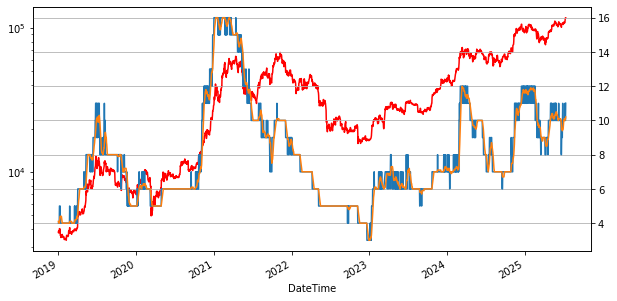| COINOTAG recommends • Exchange signup |
| 💹 Trade with pro tools |
| Fast execution, robust charts, clean risk controls. |
| 👉 Open account → |
| COINOTAG recommends • Exchange signup |
| 🚀 Smooth orders, clear control |
| Advanced order types and market depth in one view. |
| 👉 Create account → |
| COINOTAG recommends • Exchange signup |
| 📈 Clarity in volatile markets |
| Plan entries & exits, manage positions with discipline. |
| 👉 Sign up → |
| COINOTAG recommends • Exchange signup |
| ⚡ Speed, depth, reliability |
| Execute confidently when timing matters. |
| 👉 Open account → |
| COINOTAG recommends • Exchange signup |
| 🧭 A focused workflow for traders |
| Alerts, watchlists, and a repeatable process. |
| 👉 Get started → |
| COINOTAG recommends • Exchange signup |
| ✅ Data‑driven decisions |
| Focus on process—not noise. |
| 👉 Sign up → |
-
Bitcoin’s recent surge past the $120,000 mark has reignited debate on whether retail investors should resume dollar-cost averaging (DCA) strategies.
-
A $1,000 monthly Bitcoin investment over the last two years would have yielded a remarkable 114.8% return, underscoring Bitcoin’s enduring appeal as a long-term asset.
-
Market analysts remain divided: some warn the current rally may be nearing its peak, while others see room for further growth before a correction occurs, according to COINOTAG sources.
Bitcoin’s price surge to over $120,000 sparks debate on dollar-cost averaging strategies, with analysts split on whether retail investors should jump back in now.
Evaluating the Viability of Weekly Dollar-Cost Averaging into Bitcoin
Recent data from Bitbo reveals that a consistent investment of $1,000 per month into Bitcoin over the past two years would have resulted in approximately 0.4588 BTC, translating to a 114.8% return. This performance highlights Bitcoin’s resilience and its potential as a hedge against inflationary pressures.

Despite Bitcoin’s current valuation exceeding $100,000, some investors like Steve, who openly admits to not being a Bitcoin enthusiast, have committed to investing $1,000 monthly throughout the upcoming presidential term. This move reflects a growing interest among retail investors to re-enter the market amid bullish momentum.
| COINOTAG recommends • Professional traders group |
| 💎 Join a professional trading community |
| Work with senior traders, research‑backed setups, and risk‑first frameworks. |
| 👉 Join the group → |
| COINOTAG recommends • Professional traders group |
| 📊 Transparent performance, real process |
| Spot strategies with documented months of triple‑digit runs during strong trends; futures plans use defined R:R and sizing. |
| 👉 Get access → |
| COINOTAG recommends • Professional traders group |
| 🧭 Research → Plan → Execute |
| Daily levels, watchlists, and post‑trade reviews to build consistency. |
| 👉 Join now → |
| COINOTAG recommends • Professional traders group |
| 🛡️ Risk comes first |
| Sizing methods, invalidation rules, and R‑multiples baked into every plan. |
| 👉 Start today → |
| COINOTAG recommends • Professional traders group |
| 🧠 Learn the “why” behind each trade |
| Live breakdowns, playbooks, and framework‑first education. |
| 👉 Join the group → |
| COINOTAG recommends • Professional traders group |
| 🚀 Insider • APEX • INNER CIRCLE |
| Choose the depth you need—tools, coaching, and member rooms. |
| 👉 Explore tiers → |
However, industry experts like Jake Claver, managing director at Digital Ascension Group, caution against initiating DCA at this stage. Claver suggests that the market is approaching a cycle top, with limited upside remaining before a bear market ensues. He recommends waiting for a market bottom to maximize returns and advises diversifying into altcoins ahead of a potential alt season.
Conversely, crypto investor Udi Wertheimer emphasizes the importance of timing and mindset over price points. He argues that missing out on Bitcoin’s growth due to hesitation can be a costly mistake and encourages investors to adopt a long-term perspective regardless of current valuations.
| COINOTAG recommends • Exchange signup |
| 📈 Clear interface, precise orders |
| Sharp entries & exits with actionable alerts. |
| 👉 Create free account → |
| COINOTAG recommends • Exchange signup |
| 🧠 Smarter tools. Better decisions. |
| Depth analytics and risk features in one view. |
| 👉 Sign up → |
| COINOTAG recommends • Exchange signup |
| 🎯 Take control of entries & exits |
| Set alerts, define stops, execute consistently. |
| 👉 Open account → |
| COINOTAG recommends • Exchange signup |
| 🛠️ From idea to execution |
| Turn setups into plans with practical order types. |
| 👉 Join now → |
| COINOTAG recommends • Exchange signup |
| 📋 Trade your plan |
| Watchlists and routing that support focus. |
| 👉 Get started → |
| COINOTAG recommends • Exchange signup |
| 📊 Precision without the noise |
| Data‑first workflows for active traders. |
| 👉 Sign up → |
Market Sentiment and Retail Investor Behavior
Data from CryptoQuant, analyzed by Joohyun Ryu, suggests that Bitcoin has not yet reached the euphoric phase typical of market tops. The “Greed Indicator” remains at moderate levels, and the rHODL ratio, which measures long-term holder activity, is relatively low at 32%. These metrics indicate that retail investors have not fully re-engaged with the market, implying potential for further price appreciation.

| COINOTAG recommends • Traders club |
| ⚡ Futures with discipline |
| Defined R:R, pre‑set invalidation, execution checklists. |
| 👉 Join the club → |
| COINOTAG recommends • Traders club |
| 🎯 Spot strategies that compound |
| Momentum & accumulation frameworks managed with clear risk. |
| 👉 Get access → |
| COINOTAG recommends • Traders club |
| 🏛️ APEX tier for serious traders |
| Deep dives, analyst Q&A, and accountability sprints. |
| 👉 Explore APEX → |
| COINOTAG recommends • Traders club |
| 📈 Real‑time market structure |
| Key levels, liquidity zones, and actionable context. |
| 👉 Join now → |
| COINOTAG recommends • Traders club |
| 🔔 Smart alerts, not noise |
| Context‑rich notifications tied to plans and risk—never hype. |
| 👉 Get access → |
| COINOTAG recommends • Traders club |
| 🤝 Peer review & coaching |
| Hands‑on feedback that sharpens execution and risk control. |
| 👉 Join the club → |
Ryu’s analysis points to a “last dance” scenario, where Bitcoin may experience sustained growth before peaking. This perspective supports the idea that early adopters like Steve could benefit from continued accumulation ahead of a possible market top.
Strategic Considerations for Retail Investors
For retail investors contemplating re-entry into Bitcoin, the current environment presents both opportunities and risks. While historical data supports the efficacy of DCA as a risk mitigation strategy, the elevated price levels warrant caution. Investors should consider their risk tolerance, investment horizon, and market conditions before committing capital.
Engaging with credible sources and staying informed about market indicators can help investors make more calculated decisions. Additionally, diversifying across different crypto assets and maintaining a disciplined investment approach may enhance portfolio resilience.
Conclusion
The debate over resuming dollar-cost averaging into Bitcoin amid its historic price surge encapsulates broader market uncertainties. While some experts advocate patience and caution, others highlight the potential rewards of early accumulation. Ultimately, retail investors must weigh these perspectives carefully, aligning strategies with their financial goals and risk appetite to navigate the evolving crypto landscape effectively.
| COINOTAG recommends • Exchange signup |
| 📈 Clear control for futures |
| Sizing, stops, and scenario planning tools. |
| 👉 Open futures account → |
| COINOTAG recommends • Exchange signup |
| 🧩 Structure your futures trades |
| Define entries & exits with advanced orders. |
| 👉 Sign up → |
| COINOTAG recommends • Exchange signup |
| 🛡️ Control volatility |
| Automate alerts and manage positions with discipline. |
| 👉 Get started → |
| COINOTAG recommends • Exchange signup |
| ⚙️ Execution you can rely on |
| Fast routing and meaningful depth insights. |
| 👉 Create account → |
| COINOTAG recommends • Exchange signup |
| 📒 Plan. Execute. Review. |
| Frameworks for consistent decision‑making. |
| 👉 Join now → |
| COINOTAG recommends • Exchange signup |
| 🧩 Choose clarity over complexity |
| Actionable, pro‑grade tools—no fluff. |
| 👉 Open account → |
| COINOTAG recommends • Members‑only research |
| 📌 Curated setups, clearly explained |
| Entry, invalidation, targets, and R:R defined before execution. |
| 👉 Get access → |
| COINOTAG recommends • Members‑only research |
| 🧠 Data‑led decision making |
| Technical + flow + context synthesized into actionable plans. |
| 👉 Join now → |
| COINOTAG recommends • Members‑only research |
| 🧱 Consistency over hype |
| Repeatable rules, realistic expectations, and a calmer mindset. |
| 👉 Get access → |
| COINOTAG recommends • Members‑only research |
| 🕒 Patience is an edge |
| Wait for confirmation and manage risk with checklists. |
| 👉 Join now → |
| COINOTAG recommends • Members‑only research |
| 💼 Professional mentorship |
| Guidance from seasoned traders and structured feedback loops. |
| 👉 Get access → |
| COINOTAG recommends • Members‑only research |
| 🧮 Track • Review • Improve |
| Documented PnL tracking and post‑mortems to accelerate learning. |
| 👉 Join now → |








